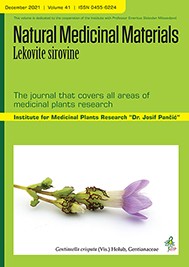Department of Plant Physiology, Institute for Biological Research “Siniša Stankovic”, University of Belgrade , Belgrade , Serbia
Department of Plant Physiology, Institute for Biological Research “Siniša Stankovic”, University of Belgrade , Belgrade , Serbia
Department of Plant Physiology, Institute for Biological Research “Siniša Stankovic”, University of Belgrade , Belgrade , Serbia
Institute of Botany and Botanical Garden “Jevremovac”, Faculty of Biology, University of Belgrade , Belgrade , Serbia
Department of Plant Physiology, Institute for Biological Research “Siniša Stankovic”, University of Belgrade , Belgrade , Serbia
Institute of Botany and Botanical Garden “Jevremovac”, Faculty of Biology, University of Belgrade , Belgrade , Serbia
Department of Plant Physiology, Institute for Biological Research “Siniša Stankovic”, University of Belgrade , Belgrade , Serbia
The following study was designed to explore antimicrobial properties of the by-product obtained in a hydro-distillation process of essential oil from Nepeta nuda L. We strived to develop a novel drink with antimicrobial self-preserving properties based on two components, N. nuda decoct and apple juice. By using 96-well plate microdilution assay it was shown that the N. nuda decoct has antimicrobial potential towards 8 bacterial and 6 fungal species, with the range of minimal inhibitory concentrations 10-300 mg/mL. By using actual food system, such as apple juice, in combination with and without short thermal treatment, we have shown that the decoct of N. nuda can inhibit the growth of food contaminant fungus Penicillium aurantiogriseum. It was determined that 3 volumes of decoct (500 mg/mL) and 22 volumes of apple juice should be mixed in order to obtain self-preserving drink resistant to P. aurantiogriseum contamination. Likewise, when thermal treatment (80 °C for 10 s) is included, self-preserving mixture of decoct and apple juice should be made in volume ratios 3:47, respectively. The designed product maintained the pleasant taste as determined by panelists during the sensorial evaluation. Chemical investigations (UHPLC–Orbitrap MS analysis) of N. nuda decoct showed that the most abundant compound was 1,5,9-epideoxyloganic acid (0.410 mg/g of dried decoct). Since N. nuda is traditionally used as a tea, we presented the novel formulation of the drink with antimicrobial properties based on the its decoct and apple juice.
This is an open access article distributed under the Creative Commons Attribution License which permits unrestricted use, distribution, and reproduction in any medium, provided the original work is properly cited.

The statements, opinions and data contained in the journal are solely those of the individual authors and contributors and not of the publisher and the editor(s). We stay neutral with regard to jurisdictional claims in published maps and institutional affiliations.